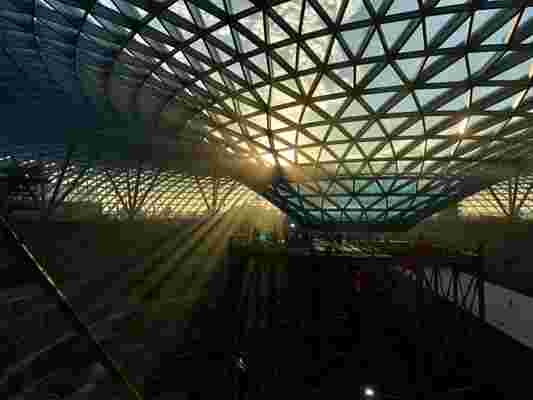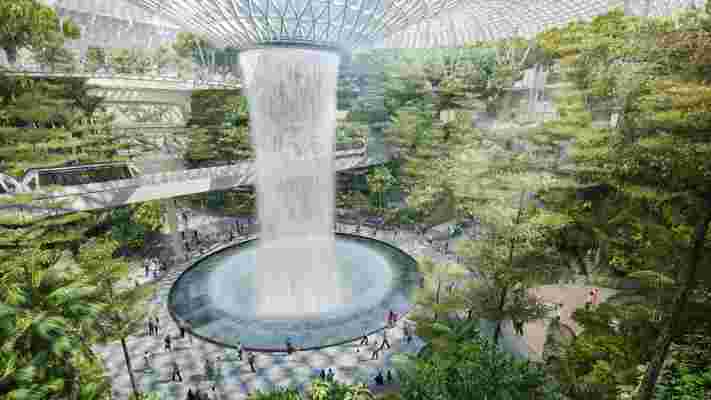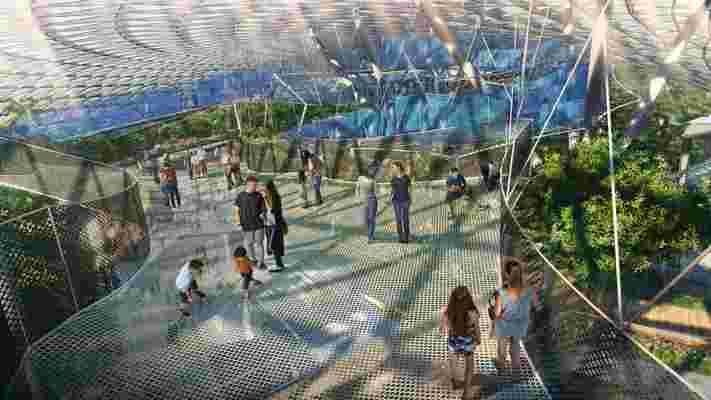World-renowned Israeli architect Moshe Safdie has been busy. His popular Marina Bay Sands hotel in Singapore , which opened in 2010, was billed as the most expensive stand-alone casino property in the world at the time, valued at $8 billion. Today, it is hard to miss on the skyline.
Now, he’s busy wrapping up his next big project, the new Jewel lifestyle destination at Changi Airport, which is set to debut in early 2019. Unusual and extensive in scope, Jewel is technically not a terminal. The idea behind the development was to position Changi Airport as a destination in and of itself, not just a place only those in transit.
As far as airports go, Changi needs no introduction: It has been named the best airport in the world for six consecutive years by the Skytrax’s World Airport Awards. With unusual attractions, including butterfly and sunflower gardens, a free movie theater, kid-friendly playgrounds, and free tours of Singapore for passengers with layovers, it has raised the bar for what other world airports should aspire towards. Currently, the four terminals accommodate over 82 million passengers annually.With Jewel around the bend, that bar has been raised even higher.

Workers construct the Jewel's skylight.
Owned by the Jewel Changi Airport Trust—which is a joint venture company formed by the Changi Airport Group (CAG) in partnership with CapitaLand Limited—the new lifestyle destination aims to be attractive to all demographics. “Places like Universal Studios or Disney can get dated very fast and people can get tired of them,” says Safdie. “We wanted to come up with something truly timeless, and the concept of a paradise garden came about."
The architect and his firm first had to submit ideas in a bidding process to CapitaLand, which would pick the winner. “As I started to sketch the design ideas, we liked the idea of a fully transparent roof over the building,” says Safdie. The sketch of a paradise garden with the largest indoor waterfall in the world helped the architectural firm win the bid.

The magnificent forest valley will features the world's largest indoor waterfall.
The destination will feature a glass and steel façade facing the airport’s Terminal 1, and have five stories above the ground as well as five subterranean levels. The core to this “timeless paradise” is the Forest Valley, a five-story garden filled with thousands of trees and plants imported from around the world. A 40-meter-tall Rain Vortex that looks almost iridescent at night will pour down the central core of the complex, with a sound-and-light show each evening.
The Canopy Park at the top level has “sky nets,” designed both for bouncing and walking. From here, visitors will be able to walk over a void and gaze down at Level 1. Mazes, designed for families and kids, give a twist to the traditional hedges, and discovery slides that double as art sculptures create some thrilling heights for those who love a good adrenaline rush.

Sky nets are designed for both walking and bouncing high above the ground floor.
Foggy Bowls, which are part of the park are another family-friendly feature: These are gently concave bowls with a constant steam of mist that create an experience of playing among the clouds (a project created in partnership with the San Francisco–based Exploratorium). The area also features two special gardens, the Topiary Walk with animal-shaped topiaries, and the Petal Garden with seasonal floral displays.
“If there ever was a place where gardens could be a key attraction, it is Singapore,” says Safdie. “But there is a difference in scale of doing this at the airport [in contrast to Marina Bay Sands],” he adds. “The idea behind the Canopy Park is that families and passengers will come, stay, and enjoy it.”
An aerial view of Jewel at Changi Airport.
Of course, the construction of Jewel was not without challenges. The idea of a transparent roof that encloses the space and appears to be magically unsupported in the center, along with its dips and folds, was not easy to execute. The resulting roof enclosure, engineered in Germany, made up of triangular glass panels that sit on a steel structure, had to be designed not only with visitors in mind, but also for the proper environment and temperature control for the precious plant life within. Safdie and his team had to find a range of plants that would thrive in an environment that was not too humid for human visitors and “that was a challenge for the landscaping team,” he adds.
The hedge maze is designed for adults and kids alike.
The seven floors dedicated to shopping, from Basement 2 to Level 5, will feature more than 280 retail outlets and a 130-room Yotel. “Jewel opens a new chapter of what the public realm can be in the city: We are used to thinking of community spaces as piazzas or malls,” Safdie says. “You don’t really think of nature at this scale at an airport.”
RELATED: Step Inside the World’s 9 Best-Looking Airport Lounges
